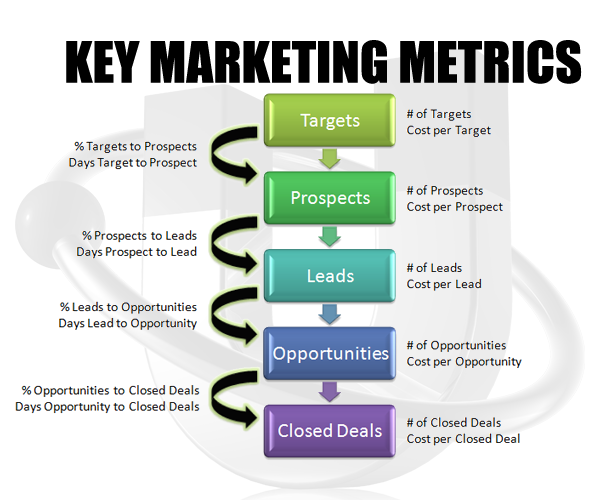If you have ever had the pleasure of presenting marketing metrics and campaign performance results to C-Suite executives, and you did not get the response you were hoping for you’re not alone. On the sales side of business, where dollars generated is the only metric that counts, it can be difficult to discuss and communicate marketing Key Performance Indicators (KPIs).
In sales, it is purely and emphatically a numbers game. How many calls can you make? How many leads can you convert? What are the opportunities a sales rep has this quarter? Of those opportunities, what is the estimated revenue we can generate? Etc. These numbers are cut and dry.
However, how do KPIs that include brand awareness, marketing leads generated, organic search results, and conversion rates translate to your sales-centric boss? If you’re one of the lucky ones, your leader understands the marketing process and the value quality leads has over the quantity of leads. For those less fortunate, you must report something, anything that gives him or her…more, more, more quantity.
What sales executive doesn’t look at quantity first? A lot know the difference between quality vs quantity, but still can’t pull themselves away from the vanity metrics (this is discussed in more detail below) that focus on quantity, even at the expense of quality. You know you have a boss that doesn’t understand true marketing when they are more concerned with website visits than the amount of a smaller quantity, yet qualified leads.
How do you educate the C-Suite without coming across as arrogant? To begin, I think it’s important to incorporate these three steps:
1. Manage expectations
Education is key. During yearly, quarterly or even monthly planning, have a conversation of what is expected of you and what goals you realistically think you can achieve. It’s extremely important to have this conversation from the get-go. It’s even more important to manage expectations. After all, it is your neck that is on-the-line.
2. Give them what they want and what they need
Sales executive want answers and visibility into how marketing leads will turn into revenue. While sales executives may not be marketing experts they do know numbers. It is the marketer’s job to effectively communicate which metrics are worth measuring as a KPI and which ones go by the waste side.
For starters, vanity metrics should be quickly diminished. Vanity metrics are the numbers that are usually the largest numbers (e.g. impressions, clicks, etc), but have very little value when it comes to lead quality. You may find that some sales executives love these numbers because the numbers are large. Vanity metrics are misleading. What these executives really want is transparency. If they really want to see the ‘vanity metrics’ than give that to them…followed by the metrics that matter most to marketers. For example:
3. Break it down for executives

Campaign: What is the name of campaign.
Impressions: How many times did your ad show up in front of someone.
Clicks: The quantity of clicks on your digital ad.
CTR: Click-Thru-Rate. The percentage of clicks divided by the number of impressions.
CPC: Cost-Per-Click. Divide the cost by the number of clicks to determine percentage.
Cost: What was the total cost of the campaign.
Leads: How many leads were generated during campaign.
CPL: Cost-Per-Lead. Divide the total cost by the quantity of leads.
Customers: The quantity of customers the campaign generated. This is your #1 KPI!
CPA: Cost-Per-Acquisition. Divide total cost by the quantity of customers. This will determine how much money spent it took to bring in a customer. If your CPA costs more than the revenue generated by the customer, it’s time to stop immediately and reevaluate this campaign.
The simple example above is a set of metrics designed for digital advertising, but these metrics are not the only ones to consider. There are several others metrics. Here’s a sample of critical marketing and sales metrics you better be tracking too.
Additional metrics you should monitor:
Reach: The total number of social media following, blog subscribers, etc.
Revenue pipeline: The total of leads generated and projected by the value of that lead based on lead close rates and average revenue per sale.
Visit-to-Lead %: How many users visited a landing page and turned into leads. Take the total number of visits and divide it by leads. This will help determine the effectiveness of your offer.
Lead-to-Marketing Qualified Lead (MQL) %: The measure of how effective marketing is at converting leads beyond the stage of having a user’s contact information.
Duration of the sales cycle: This information will also help you to identify seasonal trends (i.e. when are the marketing peaks and valleys?)
At the end of this, you should be able to come up with a document that presents what the ROI is of your marketing campaign. The metrics above will help you get to that point.
Once you’ve established KPIs of value, you will accurately measure the success or failure of your campaigns. This will also help you to align your resources to the marketing tactics that work. Remember 80% of your resources should go into the marketing tactics that provide positive results. The remaining 20% should be used to test out new marketing tactics. Developing quality metrics that is constantly monitored will pay dividends in developing your future marketing strategy.
What problems have you faced when dealing with a C-Suite that doesn’t seem to get marketing? How did you overcome this obstacle?

